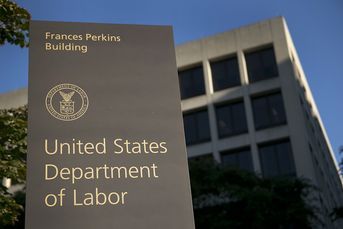What representation in the C-suite says about the gender pay gap

Few of the highest-level corporate jobs are held by women, and the difference is even more pronounced in financial services.
To better understand why the gender pay gap in the US hasn’t budged over the past 30 years, it’s helpful to look at the C-suite.
Even though women have higher college graduation rates than men and have been increasing their labor force participation, women on average were paid 82 cents per dollar compared with men as of 2022, up just a few pennies from pay rates in the mid-90s.
Yet there’s almost no difference in pay rates between men and women in the most highly compensated roles at S&P 500 companies. The problem: Only a small slice of C-suite jobs are held by women, according to a report by Morningstar and its Sustainalytics subsidiary published ahead of International Women’s Day this Friday.
“This representation gap is even more difficult to close than the pay gap,” said the report’s author, Jackie Cook, director of stewardship at Sustainalytics. “All sorts of factors come into play when it comes to why there are far fewer women at the highest-level positions.”
The most highly-paid rank, CEO, had an average total compensation of $16.7 million among S&P 500 companies as of 2022, more than twice the $8.2 million for chief technology officers, according to the report. And even while women in CEO roles out-earn male counterparts by an average of $2 million, only about 8 percent of S&P 500 CEOs are women.
Among the ranks of “named executive officers,” 64 percent of chief human resources officers are women, though the compensation for that role is a quarter of average CEO pay. Nearly 40 percent of chief legal officers are women, but pay for that role is comparably lower than that of other C-suite jobs, at $4.6 million, according to the report.
Although the percentage of women holding those highest senior-level positions has roughly doubled since 2013, going from 8.4 percent to 16.5 percent, the structural dynamics of the labor market and social policies in the US have not helped close the pay gap, Cook said.
Across the labor market, gaps in pay ramp up around the time that people have children, with women more likely to take time away from work, she said. Not only does that break from working have shorter-term consequences for career advancement, but the responsibility of having kids can be at odds with the high demands of senior-level jobs.
Women have long been underrepresented within financial services, and that also shows in the data for C-suite roles. Across all S&P 500 companies, excluding finance, 17 percent of those jobs were held by women as of 2022, according to the report. Among the 67 financial services companies in the index, that figure is 14 percent.
Further, 63 percent of companies have at least one C-suite role filled by a woman, excluding financial services, for which the rate is 55 percent, according to additional data Cook provided.
To help address the issue of extremely high compensation in the highest-level roles, and the effect those have on representation, radical reforms could be necessary, she said. The increasing use of share-based compensation, especially for CEOs, has led to their pay rising to hundreds or in some cases thousands of times the median worker compensation at the same companies.
“You can’t separate out the problems we have with CEO pay from the general representation pay problem,” Cook said, pointing to stagnating real wages for many workers. “Certain roles have become immune to the limits on pay rise that the rest of us are experiencing.”
Microcap stocks will shine now that Fed rate hikes are finished
Learn more about reprints and licensing for this article.








